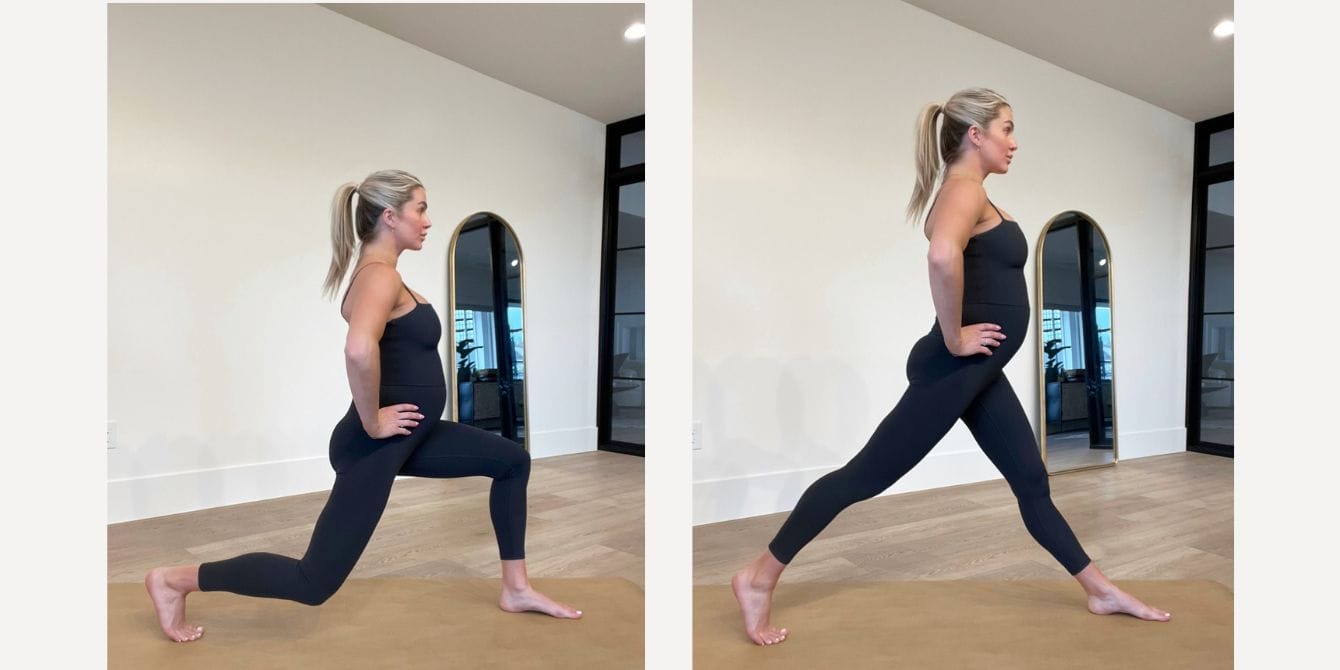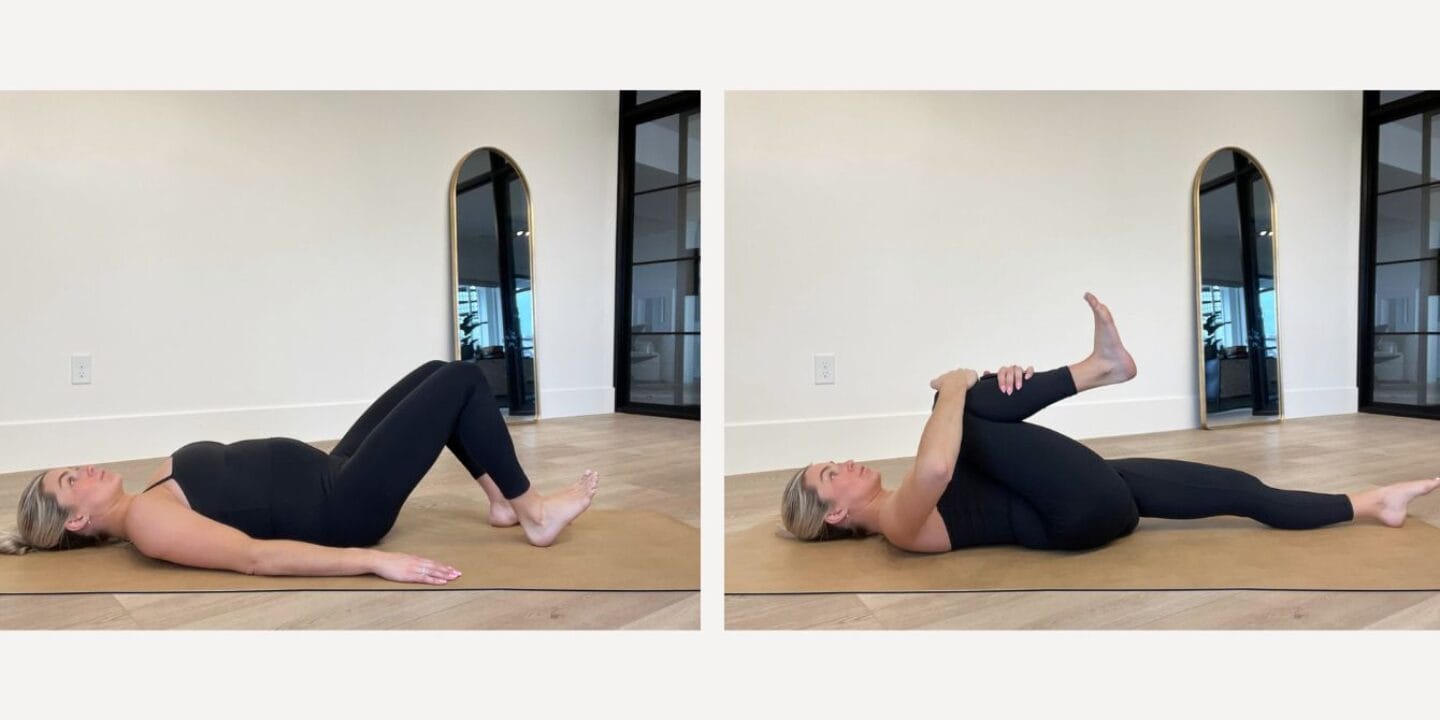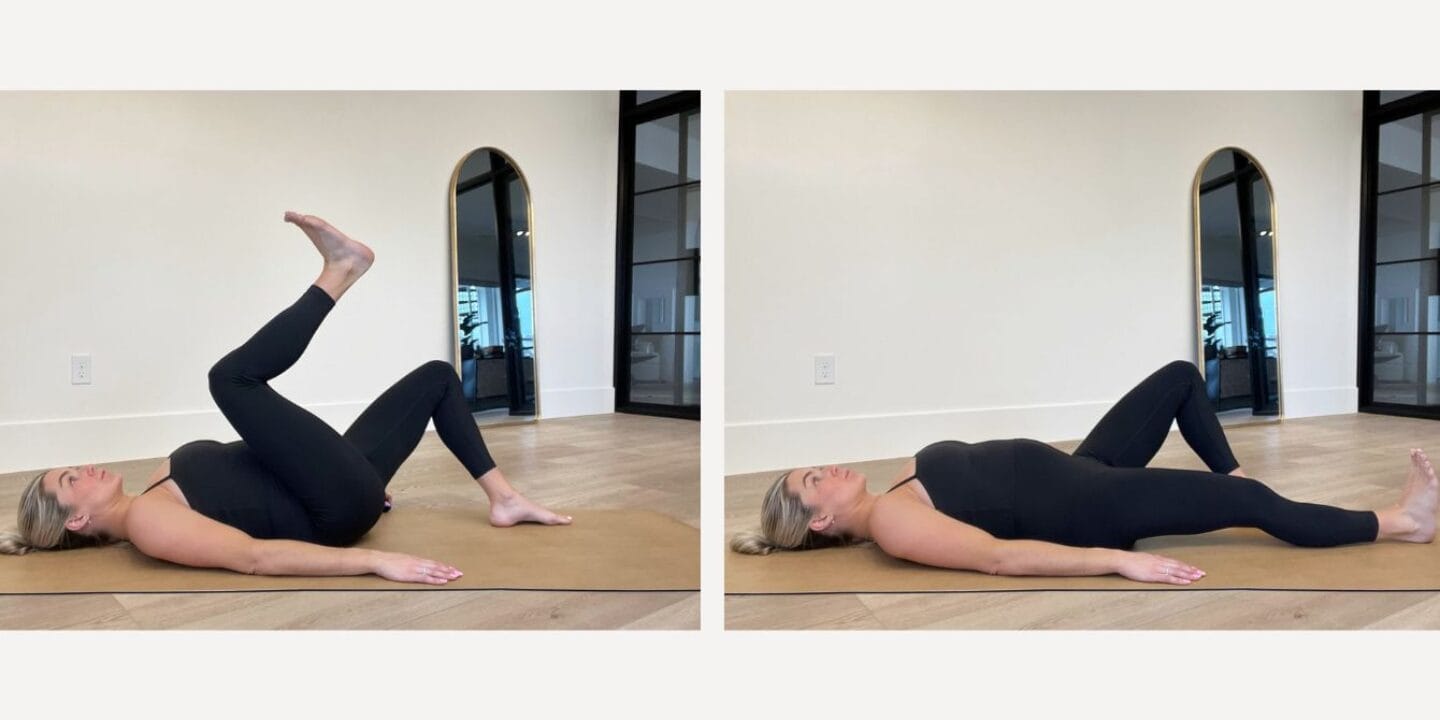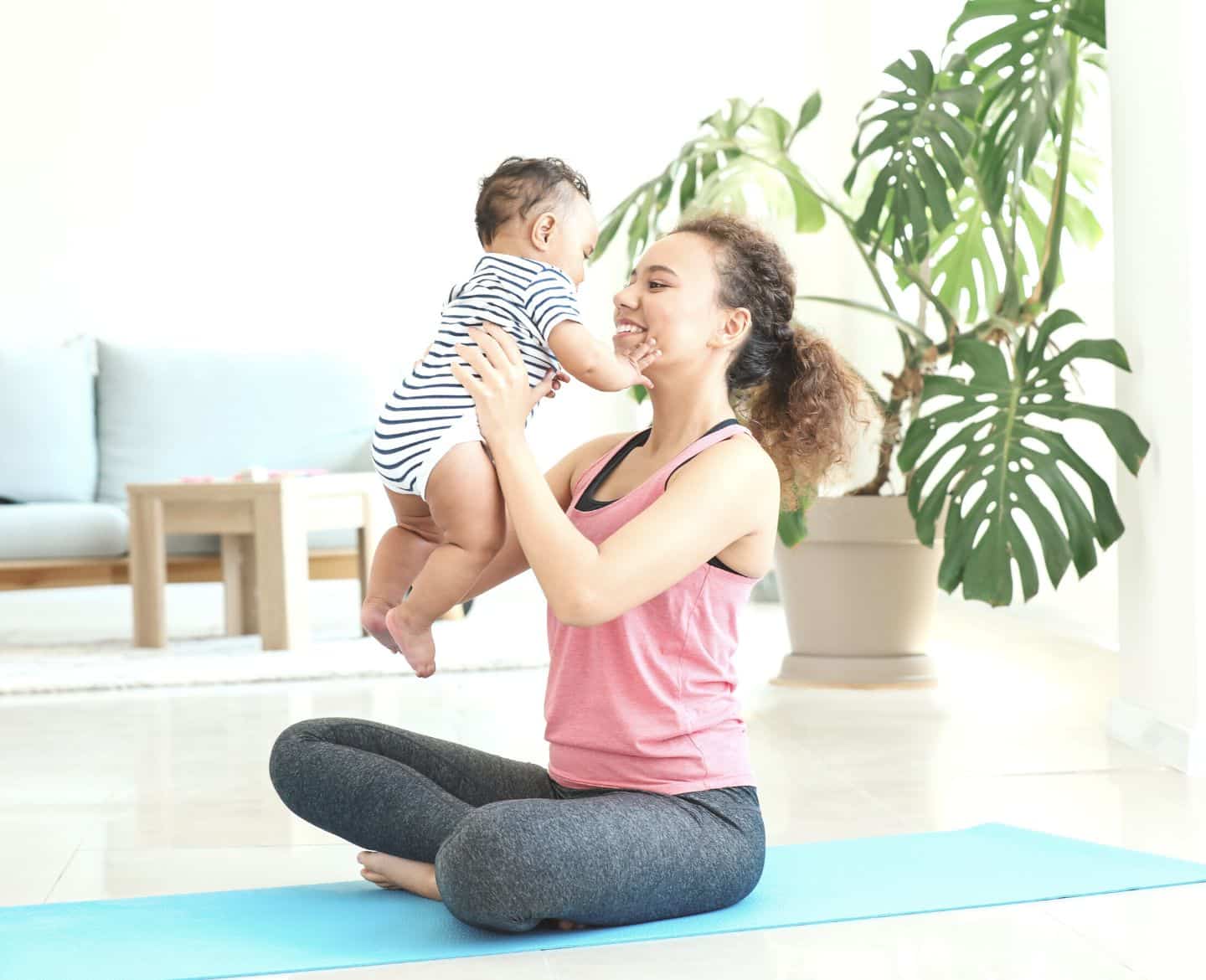Are ab workouts safe during pregnancy?

Lindsay Arnold, The Movement Club
DWTS' Lindsay Arnold shares 4 safe core moves to try in any trimester.

Table of Contents
I had been teaching yoga for 12 years before I got pregnant with my first child. It had been drilled into my head that core work of any kind was an absolute no-no if you were expecting. There were multiple reasons given during my yoga teacher trainings, like leading to long-term diastasis recti, a separation of your abdominal wall. There was even some implication that the baby could be injured. But the second I got pregnant, I started to question this absolutist thinking. What I was feeling in my body was very different from what my training manuals and the pregnancy apps were telling me. As someone who moves their body every day, I had to debunk these myths around prenatal core work once and for all.
Could I really not do a plank pose when I was just a few weeks pregnant and not yet showing? Why is it that I can pull my knee up toward my chest to tie my shoe (or at least attempt to tie it), but not while I’m lying down? There was also a lot of mixed messaging: The pregnancy apps would warn, “Make sure to exercise!” but then include a lengthy list of all the movements we are supposedly not “allowed” to do during pregnancy.
Related: Can you exercise during pregnancy or postpartum? Yes—and here’s how
What to know about doing abs while pregnant
“Dancing with the Stars” pro Lindsay Arnold received similar messaging when pregnant with her first daughter. “I remember Googling and researching core work and everywhere was like, ‘Don’t worry about it. There’s no point,’” Arnold recalled to Motherly.
As a professional dancer who knows the importance of the core for functional movement, this frustrated her immensely. In fact, it was navigating all the fear and stigma around working out while pregnant that contributed to Arnold starting her fitness platform, The Movement Club. Arnold is currently expecting her second child and she unequivocally feels that core engagement is the most beneficial type of movement she has done in both pregnancies.
As with most pregnancy related topics, things are not nearly as black and white as the internet makes them seem.
Related: How should I modify my workouts while pregnant?
The six-pack is superficial
When someone says the word core many of us picture “six-pack” abdominals, but as Deb Flashenberg, director of the Prenatal Yoga Center in New York City explains, “The core is our whole canister; it includes our diaphragm, pelvic floor, lower back muscles, and glutes/hips.”
The rectus abdominis, our “six-pack” is just one layer and as anatomists say, it is the most superficial one—though not for the reason you might be thinking. These muscles are closest to the skin and therefore the most visible to the naked eye. It’s probably also why they gain so much attention and focus: they can be seen on some bodies (not mine, but some!)
Related: I desperately needed a prenatal workout to prepare for childbirth and beyond
In isolation, their function is fairly limited. They round our back, which is important when giving our kids a hug or picking something up off the ground, but in the case of pregnancy, where stability is most essential, it is actually the deeper layers of the abdominals that matter most. The ones we don’t see.
Flashenberg tells Motherly, “When we get pregnant, the curves of our spine get exaggerated. Our lower back sways more and our upper back rounds more. The deeper abdominal layers are what support our ever-changing spine.” These include our transverse abdominis, which acts like a corset around our spine, and our pelvic floor, neither of which are accessed through crunches.
Related: 9 safe and simple pregnancy exercises for each trimester
MamasteFit co-owner Gina Conley, MS, SpBCE is calling for a reframing of what we consider core work. “Core training is so much more than doing sit ups or crunches or those traditional types of exercises,” says Conley, who just gave birth to her third child, “The core is where we anchor all of our movement from. It helps us maintain our torso position as our arms and legs move. It also supports us as we rotate and move our spine by stabilizing it.”
As such, Conley highly encourages core training to all of her pregnant and postpartum clientele. She just suggests that they focus on functional movements and stabilization exercises versus the standard sit-up.
So experts agree that core work is not only beneficial when pregnant, but essential. Then why did it get such a bad rap—and how do you navigate the noise of what might actually be dangerous?
The concern: Abdominal coning
The concern with crunch-like movements and certain other core-targeted exercises, such as plank, is coning. “This is when the center of the abdomen pushes out further than the rest,“ explains Conley. It is caused by intra-abdominal pressure and when that occurs repeatedly throughout pregnancy, studies show that the risk of long-term diastasis recti can be much higher.
Something to note is that the abdominals stretch to accommodate the growing uterus in all pregnancies. It’s when it does not come back together after giving birth that it can be concerning.

That separation is known as diastasis recti, and coning can exacerbate it. We can continue to cone postpartum, as well. It is also not limited to planks or crunches movements. We might cone when sneezing or lifting something heavy, like another child (both of which are technically core work, as Conley reminds us).
The key to doing core work successfully in pregnancy is moving mindfully by paying attention to breath and body.
4 ab workout moves that are safe in pregnancy
Editor’s note: Please always speak with your provider before engaging in any physical activity while pregnant. If you see any coning, dial back, or avoid the movement. Above all, listen to your body.
1. 360 breath

Experts may call this by different names (aka core breath, balloon breathing, diaphragmatic breathing), but most agree on its benefits. In addition to lowering the heart rate and stabilizing blood pressure, 360 breath helps tone the deepest core muscles, including the transverse abdominis and pelvic floor. It is safe to practice throughout pregnancy and into postpartum.
- Start in any position: sitting, standing or lying down
- On an inhale, imagine your rib cage widening in all directions, like a balloon
- On an exhale, release your breath completely, while imagining that you are hugging your baby in toward your spine
- Repeat for 10 full rounds
2. Bird dog

This is an expert favorite and it can be done throughout the entire pregnancy. There is always the option to come to forearms if you are dealing with any wrist pain or tingling. Flashenberg suggests starting with your back foot on the floor.
- Come to your hands and knees in a table-top position
- Straighten your right leg behind you and pause with your toes on the floor
- Imagine hugging your baby toward your spine
- Lift your left arm forward in line with your ear
- If you’re able to keep your belly well lifted and there is no coning, lift your right leg
- Hold for 5 breaths
- Lower and repeat on the opposite side
3. Split squat

During the first trimester, it is common for pregnant people to feel nauseous and have lower energy, so Conley suggests doing movements that are more upright. This movement trains you how to stay steady in your center as the legs move, which can translate to more energy-efficient, stable walking patterns, something most pregnant people need.
- Come into a lunge position, ensuring your feet are in 2 separate lanes
- Track your front knee over your ankle and be on all five of your back toes
- On an inhale, straighten both legs and on an exhale, bend both knees, so your back shin is parallel to the floor
- You may hold a weight in your hands, such as a kettlebell, but observe your tummy for coning
- Do 5 rounds on each side
4. Supine psoas lengthener and toner


This is one of Arnold’s favorite movements to do in the second trimester as it both tones and lengthens the psoas. She recommends wearing socks to really isolate the sliding action. Please keep in mind that if you start to feel any pressure or discomfort lying flat, this movement may no longer be appropriate for you.
- Lie down on your back with your knees bent and feet flat on the floor
- On an exhale, lift one foot off the floor and draw your knee in lightly toward your center
- On an inhale, place that same foot back down on the floor, flex your ankle so you are on your heel, and slide the leg to straight
- Exhale, slide your foot and knee back toward you
- Repeat five times before switching sides
Remember, you know your body best
There is a lot of mixed messaging in motherhood when it comes to what we should and should not do. It often starts during pregnancy when we are handed a packet of things we should avoid, like certain foods or exercises, but there isn’t always an accompanying packet of all the things we can do. Discernment is an important skill to hone during this tender time. You know your body best, just as you will be the one who knows your child best.
Working out while pregnant provides you with the opportunity to tune in and connect with those deeper needs, so when your baby is born, you’re prepared to navigate all the opinions and conflicting information.
This story is a part of The Motherly Collective contributor network where we showcase the stories, experiences and advice from brands, writers and experts who want to share their perspective with our community. We believe that there is no single story of motherhood, and that every mother's journey is unique. By amplifying each mother's experience and offering expert-driven content, we can support, inform and inspire each other on this incredible journey. If you're interested in contributing to The Motherly Collective please click here.


































